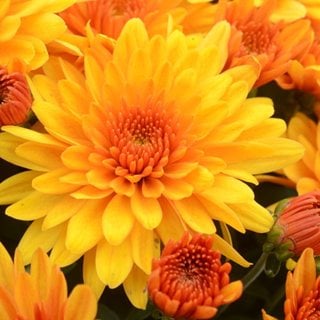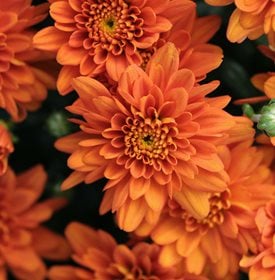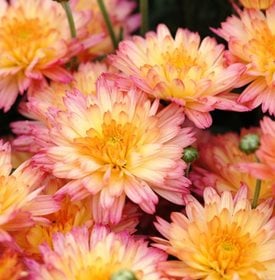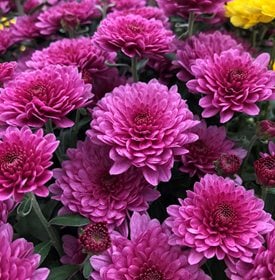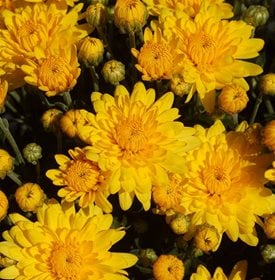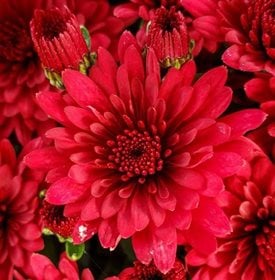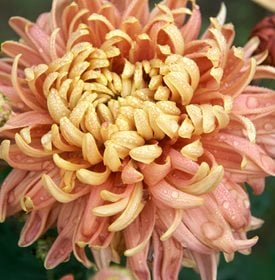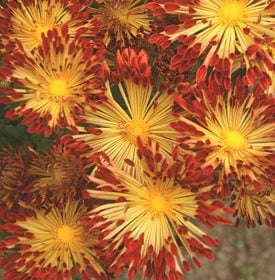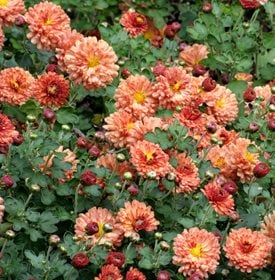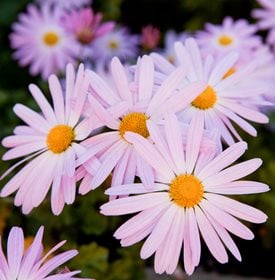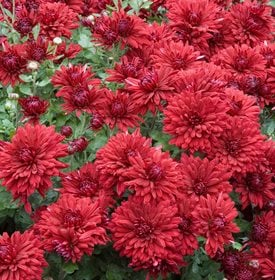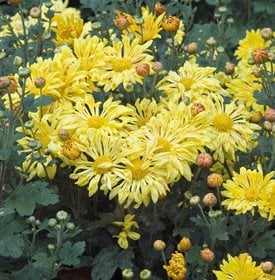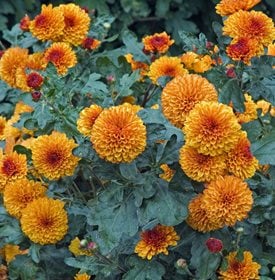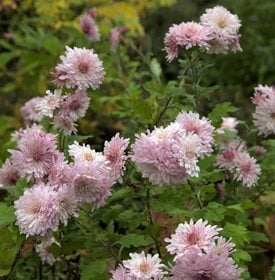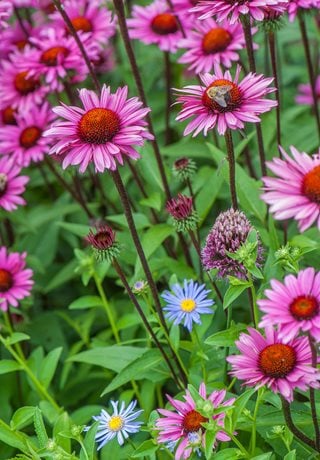Chrysanthemums: Growing, Care, & Design Tips
Learn the basics of growing and caring for this favorite fall color bloomer. Updated 9/11/25
Paradiso Pink garden mum. Photo by: Proven Winners.
Quick-Start Tips- Sun: 6-8 hours daily
- Water: Keep evenly moist, don't let pots dry out; water at soil level
- Soil: Rich, well-drained (vegetable-garden quality)
- Fertilizer: Use balanced bloom-forward formula (i.e., 5-10-5) at half strength every 2–3 weeks until buds form; stop once buds show color
- Pinching: Pinch tips every 2-3 weeks until mid-June (early bloomers) or mid-July (late bloomers)
- Spacing: 18 to 24 inches apart for airflow (fewer mildew issues)
Chrysanthemums (mums) are one of the most popular fall garden flowers. Most mum plants are easy to grow, with their basic needs being full sun, rich soil, good drainage, and good air circulation. There are hundreds of varieties available in a range of shapes and sizes that can provide blooms from late summer through fall. Chrysanthemums symbolize different things in different countries: life and rebirth in Asia, sympathy in Europe, and respect and honor in America.
On this page: Basics | Planting | Care | Reasons Mums Fail (& Fixes) | Pictures | Design Ideas | FAQS
On this page:
- BASICS
- HOW TO PLANT MUMS
- HOW TO CARE FOR MUMS
- TOP REASONS MUMS FAIL (AND FIXES)
- MUM VARIETIES
- DESIGN IDEAS
- FAQ's
BASICS
Zones:
5-9 (some varieties to zone 4).
Exposure:
Full sun (6–8 hours) produces the most blooms. Move pots to bright shade after buds color, as cooler temps slow petal aging.
Height/spread:
1 to 3 feet tall and 1 to 2 feet wide, depending on variety
Flower Color:
Chrysanthemum flowers bloom in a range of colors in shades of white, yellow, orange, lavender, purple, or red; as well as bicolor flowers.
Bloom Time:
September to frost. Known as short-day plants, flowering is triggered by the shorter days in late summer and early fall. Flowering can also be forced in a light-controlled greenhouse.
GARDEN MUM VS. FLORIST MUM:
Garden mums are bred for cold tolerance, making them suitable for planting outdoors in the right zones. Florist mums, by contrast, are greenhouse-grown for short-term display and rarely survive outdoors. To be sure you’re buying the right type, look for tags that say “hardy garden mum.”
HOW TO PLANT MUMS
When to plant:
For use as a perennial, plant in early spring or at least 6 weeks before a killing frost in fall. Planting chrysanthemums in spring will give them the best chance of surviving the following winter. If you are using them as an annual pop of fall color, plant them when blooming in late summer or early fall.
Where to plant:
Choose a sunny spot with good air circulation and well-drained soil. Avoid planting near outdoor lights, since artificial light can confuse day length and inhibit flower formation (University of Illinois Extension).
Soil:
Mums prefer rich, well-drained soil. Well-drained soil prevents root rot and supports healthy bud formation. A simple guideline is if the soil is good for vegetables, it's good for mums.
Spacing:
Plant mums 18 to 24 inches apart to allow good airflow, which helps prevent powdery mildew and other fungal diseases.
HOW TO CARE FOR MUMS
Water:
Mums require frequent watering due to their shallow root system, especially in high heat. A layer of mulch in summer will help reduce evaporation and keep roots cooler.
Fertilizer:
Mums are not big feeders. Use a balanced or bloom-forward formula (i.e., 5-10-5) at half strength every 2 to 3 weeks from spring to bud set; stop once buds show color.
Pinching/pruning:
Pinch approximately 1 inch from the branch tips two to three times during the growing season to encourage branching and a sturdier plant. Early bloomers that flower in mid-September should be pinched no later than mid-June. October bloomers can be pinched up until mid-July, with the guideline not to pinch within 3 months of bloom time.
Propagation:
When grown as perennials, they can be divided every two to three years in the spring. Dig up the plant when new growth begins to appear, discard the dying center and re-plant the new shoots around the outside of the plant. They can also be grown from cuttings taken in the spring. Cut just below a leaf node and root in sterile potting soil. The new plants should be watered daily and kept on a sunny windowsill until established.
Overwintering:
- Zones 5-6: In fall, leave stems standing, mulch 4 to 6 inches with straw or leaves after a hard frost; cut back in spring.
- Zones 7-9: After bloom, cut to 6 inches and mulch lightly.
Diseases and Pests:
Leaf spot, powdery mildew, and botrytis thrive in shade and crowded conditions. Space plants 18 to 24 inches apart and water early in the day to keep leaves dry. Pests include aphids, spider mites, leafminers, and caterpillars; start with a strong water spray, then use insecticidal soap or neem oil if needed.
Container care:
Use a container with drainage holes (at least 12 inches wide), fill with a rich, well-draining potting mix (not garden soil), and water thoroughly whenever the top inch is dry; pots can dry out quickly in heat. Move pots to bright shade when plants bloom to extend color. In cold regions, overwinter pots in an unheated garage or shed and water just enough to keep the soil from fully drying out. See 3 ways to overwinter your potted mums in this video from Sean at Spoken Garden.
TOP REASONS MUMS FAIL (AND FIXES)
Even though mums are easy-care, many gardeners run into the same pitfalls. Here are the top reasons mums fail—and how to fix them.
- Planted too late: Roots can't establish before a freeze; plant in spring or at least 6 weeks before first frost.
- Poor drainage: Raise bed or use containers with drainage holes.
- No pinching: Leggy plants flop; pinch tips through early summer for sturdier growth.
- Dry pots: Mums have shallow roots that dry out easily; check moisture daily, especially in heat; add 1 to 2 inches of mulch.
MUM VARIETIES
DESIGN IDEAS
Chrysanthemums are great for growing directly in the garden or in containers, here are some ideas:
- Perfect for containers and baskets because of their shallow-rooting habit.
- Use as an annual in the fall to fill in and replace summer-blooming annuals.
- Think 'thriller' (ornamental grass), 'filler' (mum), 'spiller' (trailing ivy or lysimachia) for container planting.
- With the many color varieties available, mums can provide coordinating or contrasting color accents indoors and out.
- Echo a door or cushion color with matching mums to make small spaces pop.
- They are relatively inexpensive, making them a great choice for large groupings or repeating throughout an area.
- Grow beside other fall-blooming plants like coneflower, sedum, aster, bluebeard, and pansies.
- Penn State Extension suggests, "Choose one or two colors to get a maximum effect far away. Or, arrange a gradual transition of related colors. If you decorate with pumpkins and gourds, choose orange, yellow, and creamy white mums. For a yard that has a lot of green foliage, try bright pinks, lavenders, whites, or reds."
FREQUENTLY ASKED QUESTIONS
Are mums annuals or perennials?
Although the most widely available mums are grown as fall annuals, there are varieties that can also be grown as perennials in some regions with a little care to overwinter them. In colder zones, leave the top growth in place and add loose mulch such as straw or evergreen branches around them for protection, waiting to cut back in spring after new growth emerges. In warmer winter climates, they can be cut back to 6” tall after flowering. Check your local garden center to see what varieties work best in your area.
Should I deadhead mums?
Snip spent flower clusters to keep plants tidy and redirect energy to new buds.
Can I plant store-bought mums in the ground?
Yes, but florist mums usually aren’t hardy enough to grow outdoors; for best odds, plant hardy garden mums in spring.
Are mums poisonous to cats, dogs or other animals?
Mums do contain substances that are toxic to cats, dogs, and horses if ingested, so be sure to keep this in mind when choosing a location that might be explored by curious pets. See more Common Poisonous Plants for Dogs and Cats.
Are mums deer and rabbit resistant?
Deer and rabbits tend to avoid plants with fragrant leaves and fuzzy texture, both of which are attributes of mums, making them fairly resistant.
ABOUT THE AUTHOR
Linda Hagen is a writer and content coordinator at GardenDesign.com, where she combines firsthand gardening experience with expert insights. Based in Southern California (Zone 9B), she’s passionate about vibrant, pollinator-friendly gardens and believes the best lessons come from a trial-and-error approach to growing .
Related:
Homecoming Mums: A Texas Tradition
25 Fall-Blooming Perennials
Asters
Growing Gerbera Daisies

